Human Resource Management: State's Role & Legislation Objectives
VerifiedAdded on 2023/06/10
|6
|1454
|438
Essay
AI Summary
This essay provides a comprehensive analysis of the state's role in industrial relations, focusing on its functions as a legislator, executor, and judicial system. It examines the objectives of industrial relations legislation, including the recognition of employer and trade union associations, employee compensation and protection, and collective bargaining procedures. The essay also discusses the state's role as an employer, income tax policy maker, and its influence on workers' take-home pay. Examples from countries like Fiji and Australia are used to illustrate the practical application of these concepts. The document concludes by emphasizing the importance of understanding these functions for effective management of activities within industrial relations.
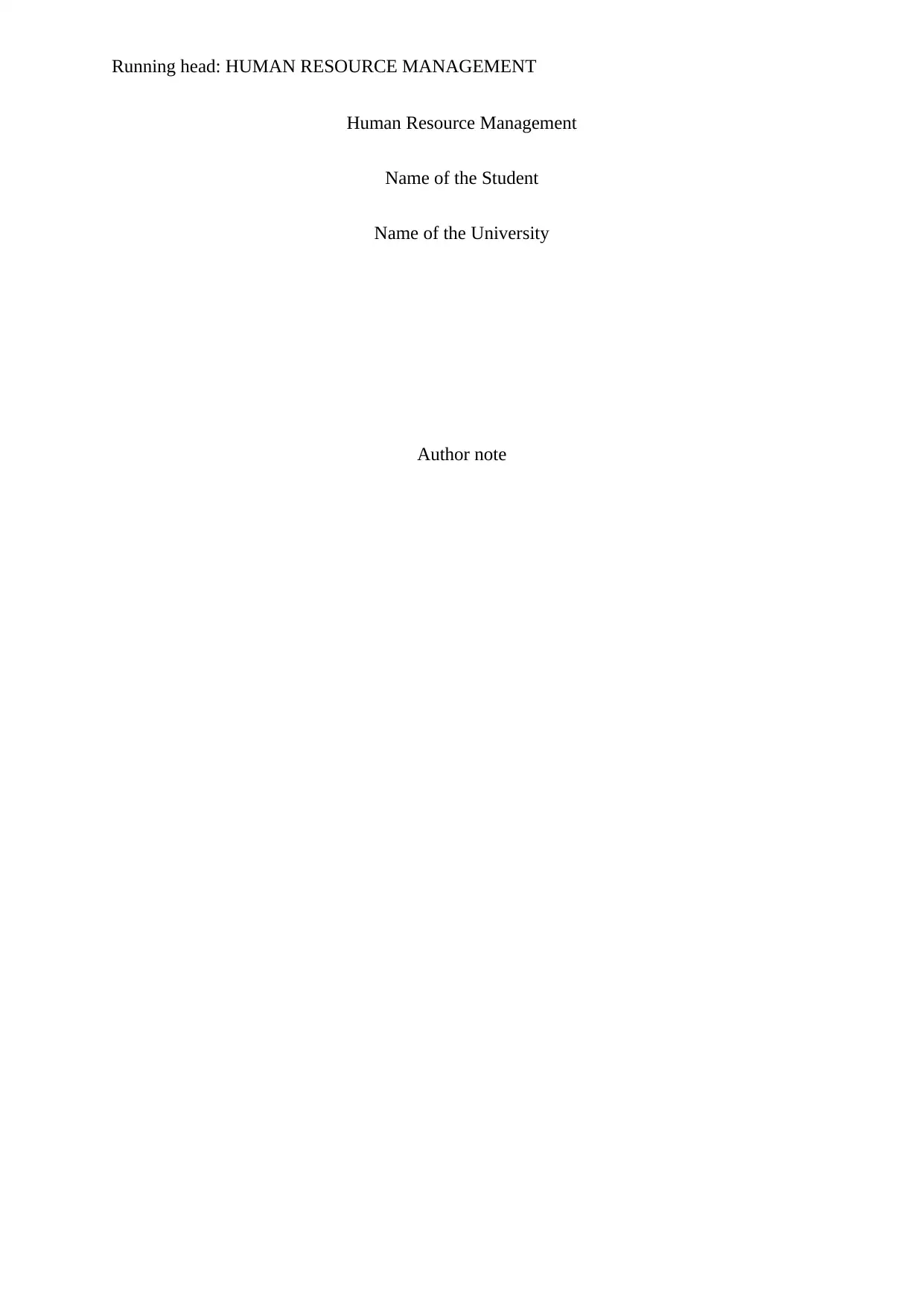
Running head: HUMAN RESOURCE MANAGEMENT
Human Resource Management
Name of the Student
Name of the University
Author note
Human Resource Management
Name of the Student
Name of the University
Author note
Paraphrase This Document
Need a fresh take? Get an instant paraphrase of this document with our AI Paraphraser
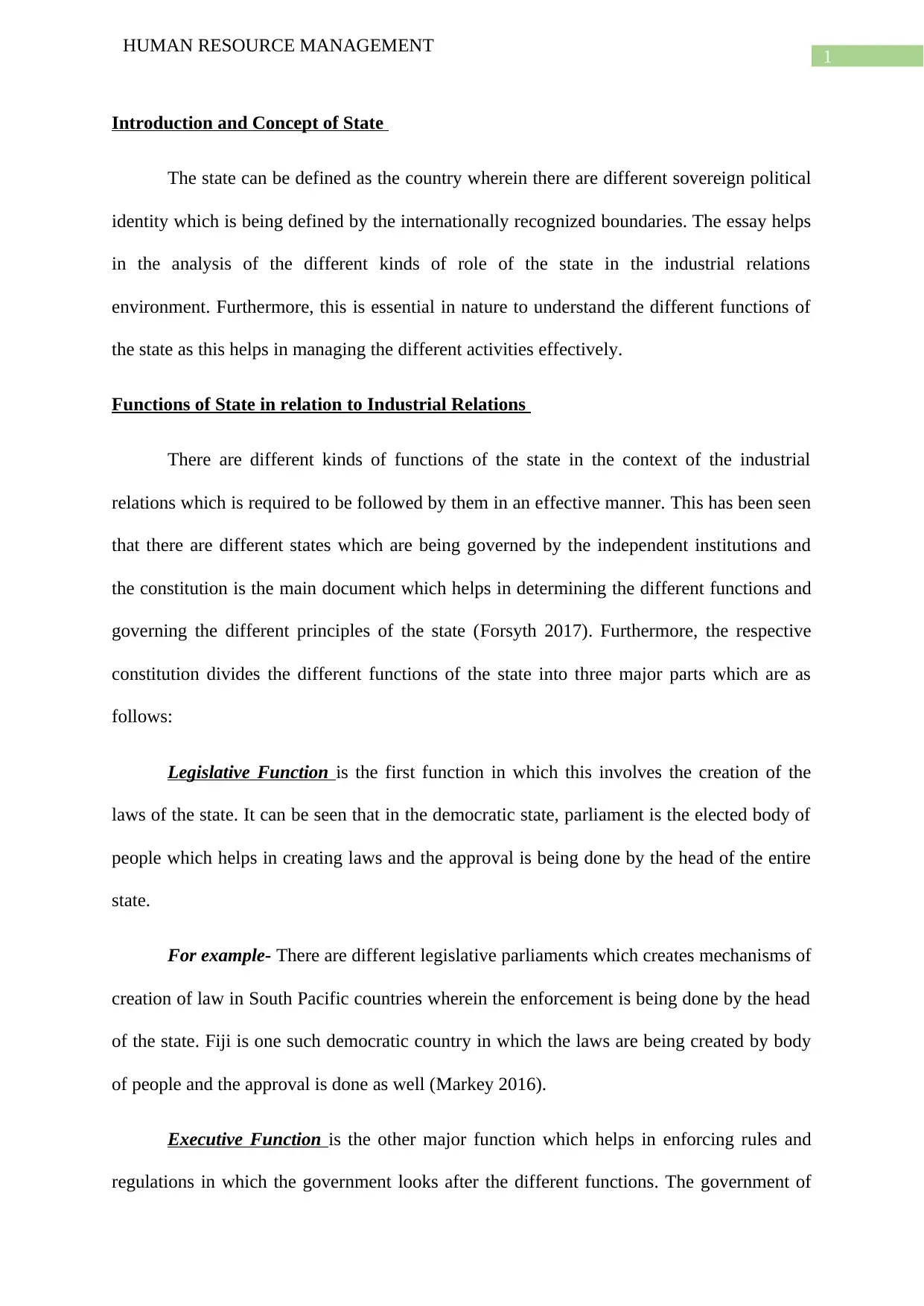
1
HUMAN RESOURCE MANAGEMENT
Introduction and Concept of State
The state can be defined as the country wherein there are different sovereign political
identity which is being defined by the internationally recognized boundaries. The essay helps
in the analysis of the different kinds of role of the state in the industrial relations
environment. Furthermore, this is essential in nature to understand the different functions of
the state as this helps in managing the different activities effectively.
Functions of State in relation to Industrial Relations
There are different kinds of functions of the state in the context of the industrial
relations which is required to be followed by them in an effective manner. This has been seen
that there are different states which are being governed by the independent institutions and
the constitution is the main document which helps in determining the different functions and
governing the different principles of the state (Forsyth 2017). Furthermore, the respective
constitution divides the different functions of the state into three major parts which are as
follows:
Legislative Function is the first function in which this involves the creation of the
laws of the state. It can be seen that in the democratic state, parliament is the elected body of
people which helps in creating laws and the approval is being done by the head of the entire
state.
For example- There are different legislative parliaments which creates mechanisms of
creation of law in South Pacific countries wherein the enforcement is being done by the head
of the state. Fiji is one such democratic country in which the laws are being created by body
of people and the approval is done as well (Markey 2016).
Executive Function is the other major function which helps in enforcing rules and
regulations in which the government looks after the different functions. The government of
HUMAN RESOURCE MANAGEMENT
Introduction and Concept of State
The state can be defined as the country wherein there are different sovereign political
identity which is being defined by the internationally recognized boundaries. The essay helps
in the analysis of the different kinds of role of the state in the industrial relations
environment. Furthermore, this is essential in nature to understand the different functions of
the state as this helps in managing the different activities effectively.
Functions of State in relation to Industrial Relations
There are different kinds of functions of the state in the context of the industrial
relations which is required to be followed by them in an effective manner. This has been seen
that there are different states which are being governed by the independent institutions and
the constitution is the main document which helps in determining the different functions and
governing the different principles of the state (Forsyth 2017). Furthermore, the respective
constitution divides the different functions of the state into three major parts which are as
follows:
Legislative Function is the first function in which this involves the creation of the
laws of the state. It can be seen that in the democratic state, parliament is the elected body of
people which helps in creating laws and the approval is being done by the head of the entire
state.
For example- There are different legislative parliaments which creates mechanisms of
creation of law in South Pacific countries wherein the enforcement is being done by the head
of the state. Fiji is one such democratic country in which the laws are being created by body
of people and the approval is done as well (Markey 2016).
Executive Function is the other major function which helps in enforcing rules and
regulations in which the government looks after the different functions. The government of
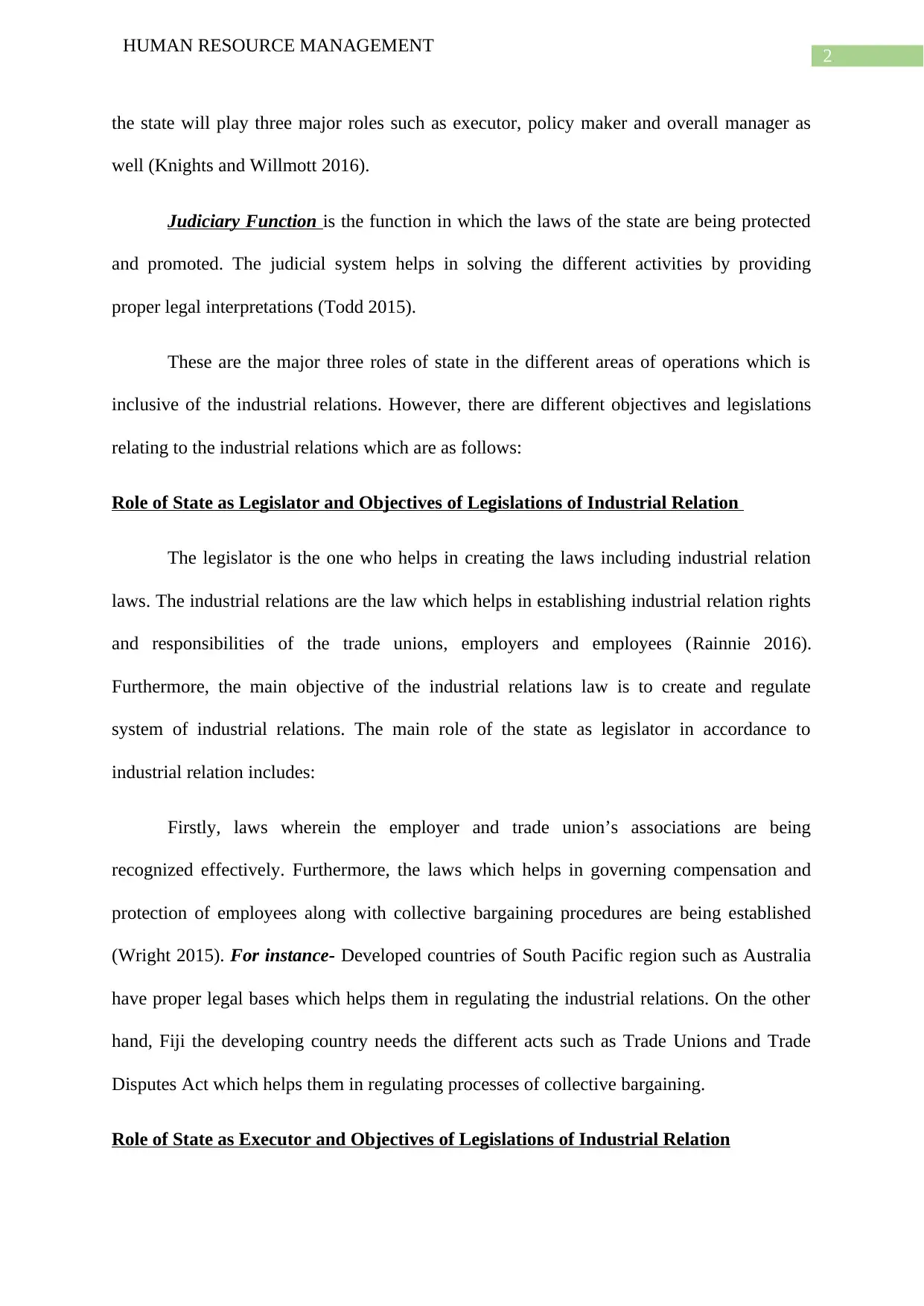
2
HUMAN RESOURCE MANAGEMENT
the state will play three major roles such as executor, policy maker and overall manager as
well (Knights and Willmott 2016).
Judiciary Function is the function in which the laws of the state are being protected
and promoted. The judicial system helps in solving the different activities by providing
proper legal interpretations (Todd 2015).
These are the major three roles of state in the different areas of operations which is
inclusive of the industrial relations. However, there are different objectives and legislations
relating to the industrial relations which are as follows:
Role of State as Legislator and Objectives of Legislations of Industrial Relation
The legislator is the one who helps in creating the laws including industrial relation
laws. The industrial relations are the law which helps in establishing industrial relation rights
and responsibilities of the trade unions, employers and employees (Rainnie 2016).
Furthermore, the main objective of the industrial relations law is to create and regulate
system of industrial relations. The main role of the state as legislator in accordance to
industrial relation includes:
Firstly, laws wherein the employer and trade union’s associations are being
recognized effectively. Furthermore, the laws which helps in governing compensation and
protection of employees along with collective bargaining procedures are being established
(Wright 2015). For instance- Developed countries of South Pacific region such as Australia
have proper legal bases which helps them in regulating the industrial relations. On the other
hand, Fiji the developing country needs the different acts such as Trade Unions and Trade
Disputes Act which helps them in regulating processes of collective bargaining.
Role of State as Executor and Objectives of Legislations of Industrial Relation
HUMAN RESOURCE MANAGEMENT
the state will play three major roles such as executor, policy maker and overall manager as
well (Knights and Willmott 2016).
Judiciary Function is the function in which the laws of the state are being protected
and promoted. The judicial system helps in solving the different activities by providing
proper legal interpretations (Todd 2015).
These are the major three roles of state in the different areas of operations which is
inclusive of the industrial relations. However, there are different objectives and legislations
relating to the industrial relations which are as follows:
Role of State as Legislator and Objectives of Legislations of Industrial Relation
The legislator is the one who helps in creating the laws including industrial relation
laws. The industrial relations are the law which helps in establishing industrial relation rights
and responsibilities of the trade unions, employers and employees (Rainnie 2016).
Furthermore, the main objective of the industrial relations law is to create and regulate
system of industrial relations. The main role of the state as legislator in accordance to
industrial relation includes:
Firstly, laws wherein the employer and trade union’s associations are being
recognized effectively. Furthermore, the laws which helps in governing compensation and
protection of employees along with collective bargaining procedures are being established
(Wright 2015). For instance- Developed countries of South Pacific region such as Australia
have proper legal bases which helps them in regulating the industrial relations. On the other
hand, Fiji the developing country needs the different acts such as Trade Unions and Trade
Disputes Act which helps them in regulating processes of collective bargaining.
Role of State as Executor and Objectives of Legislations of Industrial Relation
⊘ This is a preview!⊘
Do you want full access?
Subscribe today to unlock all pages.

Trusted by 1+ million students worldwide
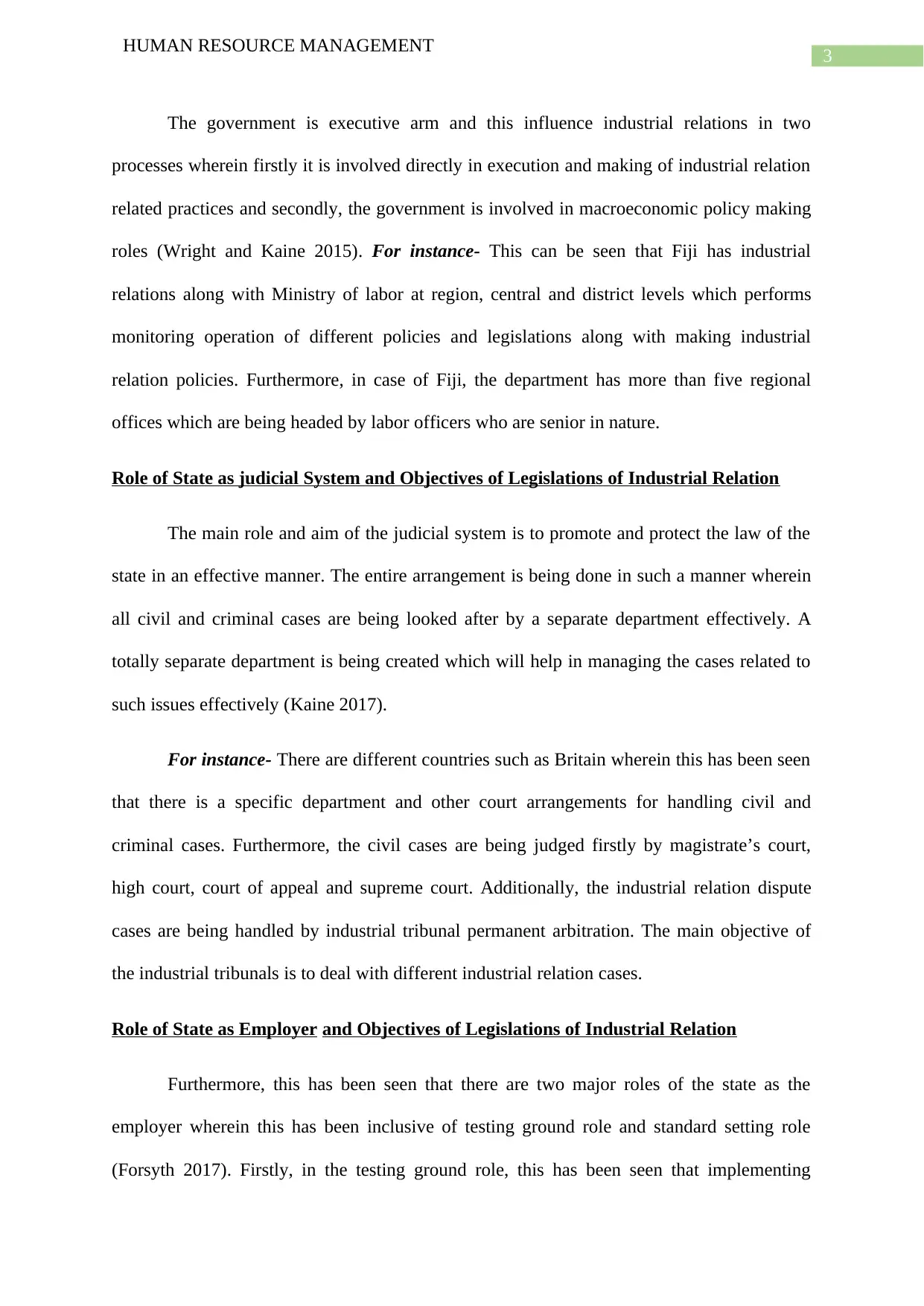
3
HUMAN RESOURCE MANAGEMENT
The government is executive arm and this influence industrial relations in two
processes wherein firstly it is involved directly in execution and making of industrial relation
related practices and secondly, the government is involved in macroeconomic policy making
roles (Wright and Kaine 2015). For instance- This can be seen that Fiji has industrial
relations along with Ministry of labor at region, central and district levels which performs
monitoring operation of different policies and legislations along with making industrial
relation policies. Furthermore, in case of Fiji, the department has more than five regional
offices which are being headed by labor officers who are senior in nature.
Role of State as judicial System and Objectives of Legislations of Industrial Relation
The main role and aim of the judicial system is to promote and protect the law of the
state in an effective manner. The entire arrangement is being done in such a manner wherein
all civil and criminal cases are being looked after by a separate department effectively. A
totally separate department is being created which will help in managing the cases related to
such issues effectively (Kaine 2017).
For instance- There are different countries such as Britain wherein this has been seen
that there is a specific department and other court arrangements for handling civil and
criminal cases. Furthermore, the civil cases are being judged firstly by magistrate’s court,
high court, court of appeal and supreme court. Additionally, the industrial relation dispute
cases are being handled by industrial tribunal permanent arbitration. The main objective of
the industrial tribunals is to deal with different industrial relation cases.
Role of State as Employer and Objectives of Legislations of Industrial Relation
Furthermore, this has been seen that there are two major roles of the state as the
employer wherein this has been inclusive of testing ground role and standard setting role
(Forsyth 2017). Firstly, in the testing ground role, this has been seen that implementing
HUMAN RESOURCE MANAGEMENT
The government is executive arm and this influence industrial relations in two
processes wherein firstly it is involved directly in execution and making of industrial relation
related practices and secondly, the government is involved in macroeconomic policy making
roles (Wright and Kaine 2015). For instance- This can be seen that Fiji has industrial
relations along with Ministry of labor at region, central and district levels which performs
monitoring operation of different policies and legislations along with making industrial
relation policies. Furthermore, in case of Fiji, the department has more than five regional
offices which are being headed by labor officers who are senior in nature.
Role of State as judicial System and Objectives of Legislations of Industrial Relation
The main role and aim of the judicial system is to promote and protect the law of the
state in an effective manner. The entire arrangement is being done in such a manner wherein
all civil and criminal cases are being looked after by a separate department effectively. A
totally separate department is being created which will help in managing the cases related to
such issues effectively (Kaine 2017).
For instance- There are different countries such as Britain wherein this has been seen
that there is a specific department and other court arrangements for handling civil and
criminal cases. Furthermore, the civil cases are being judged firstly by magistrate’s court,
high court, court of appeal and supreme court. Additionally, the industrial relation dispute
cases are being handled by industrial tribunal permanent arbitration. The main objective of
the industrial tribunals is to deal with different industrial relation cases.
Role of State as Employer and Objectives of Legislations of Industrial Relation
Furthermore, this has been seen that there are two major roles of the state as the
employer wherein this has been inclusive of testing ground role and standard setting role
(Forsyth 2017). Firstly, in the testing ground role, this has been seen that implementing
Paraphrase This Document
Need a fresh take? Get an instant paraphrase of this document with our AI Paraphraser
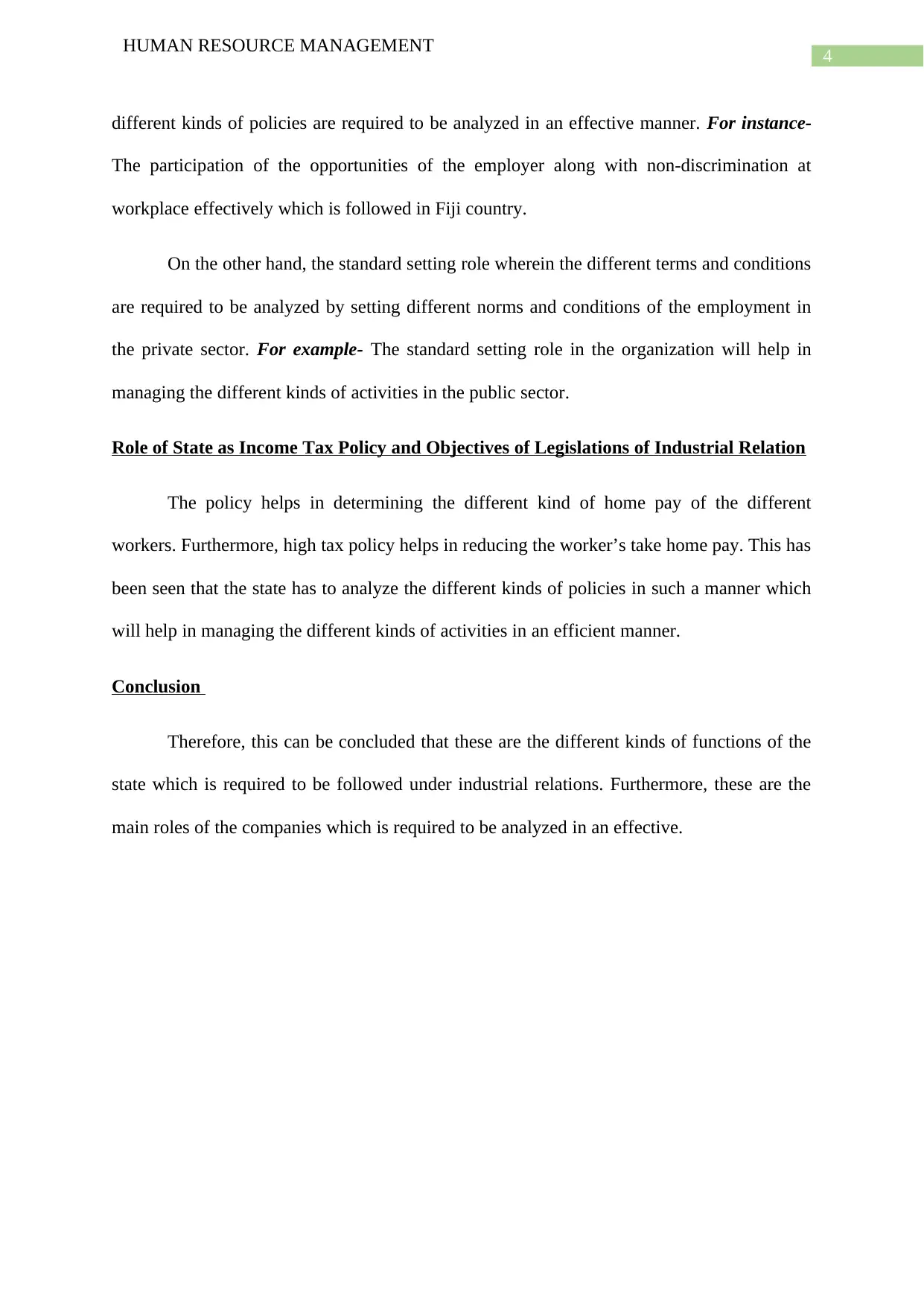
4
HUMAN RESOURCE MANAGEMENT
different kinds of policies are required to be analyzed in an effective manner. For instance-
The participation of the opportunities of the employer along with non-discrimination at
workplace effectively which is followed in Fiji country.
On the other hand, the standard setting role wherein the different terms and conditions
are required to be analyzed by setting different norms and conditions of the employment in
the private sector. For example- The standard setting role in the organization will help in
managing the different kinds of activities in the public sector.
Role of State as Income Tax Policy and Objectives of Legislations of Industrial Relation
The policy helps in determining the different kind of home pay of the different
workers. Furthermore, high tax policy helps in reducing the worker’s take home pay. This has
been seen that the state has to analyze the different kinds of policies in such a manner which
will help in managing the different kinds of activities in an efficient manner.
Conclusion
Therefore, this can be concluded that these are the different kinds of functions of the
state which is required to be followed under industrial relations. Furthermore, these are the
main roles of the companies which is required to be analyzed in an effective.
HUMAN RESOURCE MANAGEMENT
different kinds of policies are required to be analyzed in an effective manner. For instance-
The participation of the opportunities of the employer along with non-discrimination at
workplace effectively which is followed in Fiji country.
On the other hand, the standard setting role wherein the different terms and conditions
are required to be analyzed by setting different norms and conditions of the employment in
the private sector. For example- The standard setting role in the organization will help in
managing the different kinds of activities in the public sector.
Role of State as Income Tax Policy and Objectives of Legislations of Industrial Relation
The policy helps in determining the different kind of home pay of the different
workers. Furthermore, high tax policy helps in reducing the worker’s take home pay. This has
been seen that the state has to analyze the different kinds of policies in such a manner which
will help in managing the different kinds of activities in an efficient manner.
Conclusion
Therefore, this can be concluded that these are the different kinds of functions of the
state which is required to be followed under industrial relations. Furthermore, these are the
main roles of the companies which is required to be analyzed in an effective.
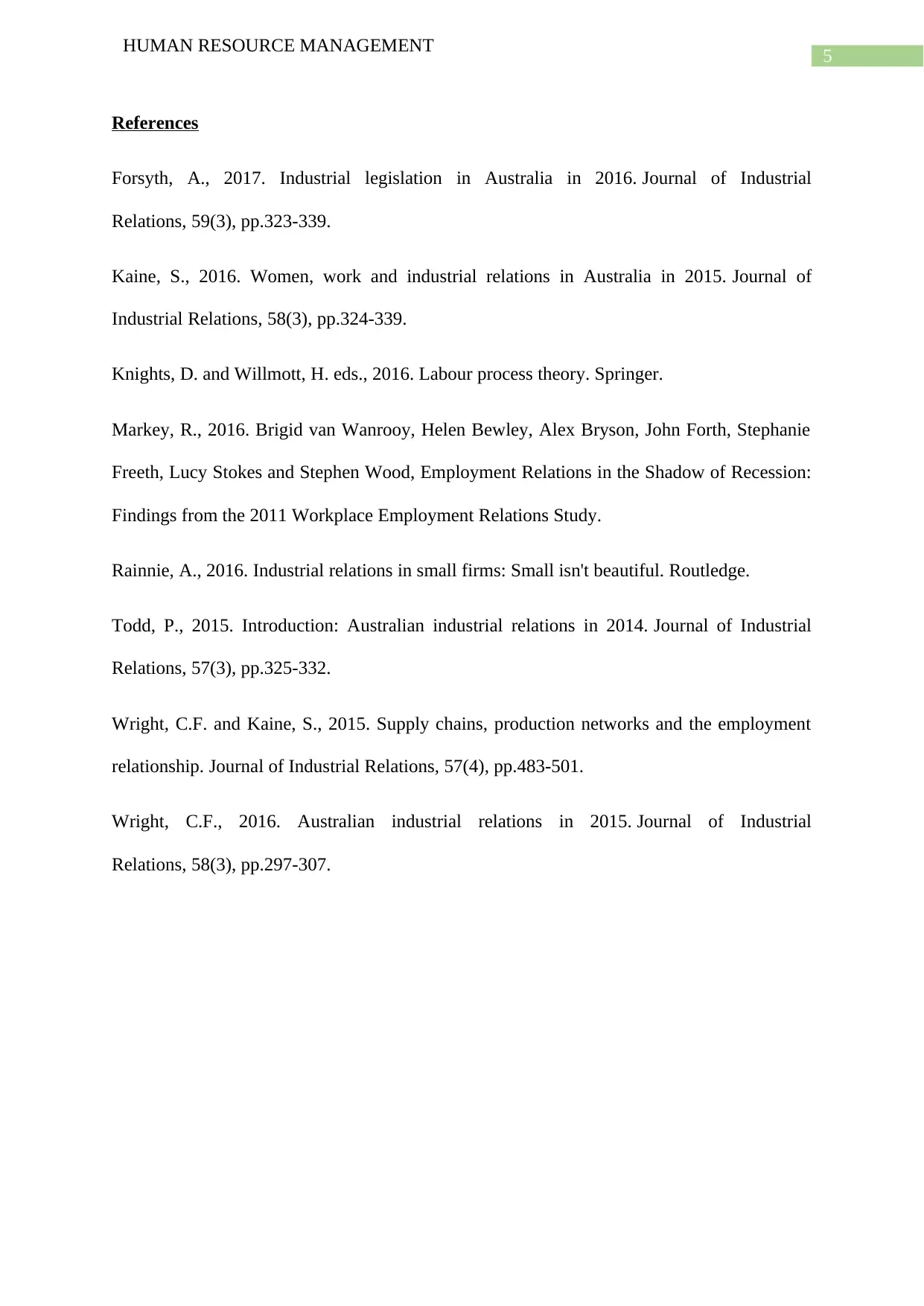
5
HUMAN RESOURCE MANAGEMENT
References
Forsyth, A., 2017. Industrial legislation in Australia in 2016. Journal of Industrial
Relations, 59(3), pp.323-339.
Kaine, S., 2016. Women, work and industrial relations in Australia in 2015. Journal of
Industrial Relations, 58(3), pp.324-339.
Knights, D. and Willmott, H. eds., 2016. Labour process theory. Springer.
Markey, R., 2016. Brigid van Wanrooy, Helen Bewley, Alex Bryson, John Forth, Stephanie
Freeth, Lucy Stokes and Stephen Wood, Employment Relations in the Shadow of Recession:
Findings from the 2011 Workplace Employment Relations Study.
Rainnie, A., 2016. Industrial relations in small firms: Small isn't beautiful. Routledge.
Todd, P., 2015. Introduction: Australian industrial relations in 2014. Journal of Industrial
Relations, 57(3), pp.325-332.
Wright, C.F. and Kaine, S., 2015. Supply chains, production networks and the employment
relationship. Journal of Industrial Relations, 57(4), pp.483-501.
Wright, C.F., 2016. Australian industrial relations in 2015. Journal of Industrial
Relations, 58(3), pp.297-307.
HUMAN RESOURCE MANAGEMENT
References
Forsyth, A., 2017. Industrial legislation in Australia in 2016. Journal of Industrial
Relations, 59(3), pp.323-339.
Kaine, S., 2016. Women, work and industrial relations in Australia in 2015. Journal of
Industrial Relations, 58(3), pp.324-339.
Knights, D. and Willmott, H. eds., 2016. Labour process theory. Springer.
Markey, R., 2016. Brigid van Wanrooy, Helen Bewley, Alex Bryson, John Forth, Stephanie
Freeth, Lucy Stokes and Stephen Wood, Employment Relations in the Shadow of Recession:
Findings from the 2011 Workplace Employment Relations Study.
Rainnie, A., 2016. Industrial relations in small firms: Small isn't beautiful. Routledge.
Todd, P., 2015. Introduction: Australian industrial relations in 2014. Journal of Industrial
Relations, 57(3), pp.325-332.
Wright, C.F. and Kaine, S., 2015. Supply chains, production networks and the employment
relationship. Journal of Industrial Relations, 57(4), pp.483-501.
Wright, C.F., 2016. Australian industrial relations in 2015. Journal of Industrial
Relations, 58(3), pp.297-307.
⊘ This is a preview!⊘
Do you want full access?
Subscribe today to unlock all pages.

Trusted by 1+ million students worldwide
1 out of 6
Related Documents
Your All-in-One AI-Powered Toolkit for Academic Success.
+13062052269
info@desklib.com
Available 24*7 on WhatsApp / Email
![[object Object]](/_next/static/media/star-bottom.7253800d.svg)
Unlock your academic potential
Copyright © 2020–2025 A2Z Services. All Rights Reserved. Developed and managed by ZUCOL.





